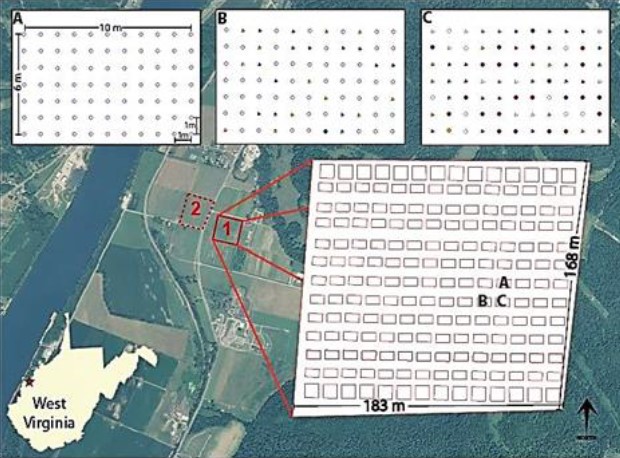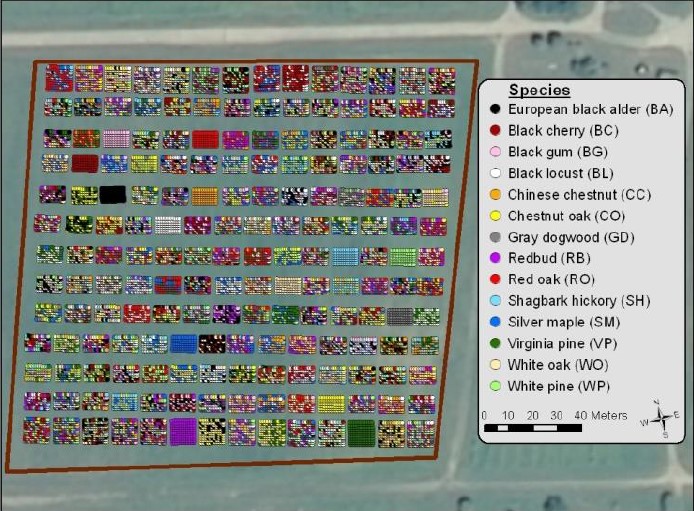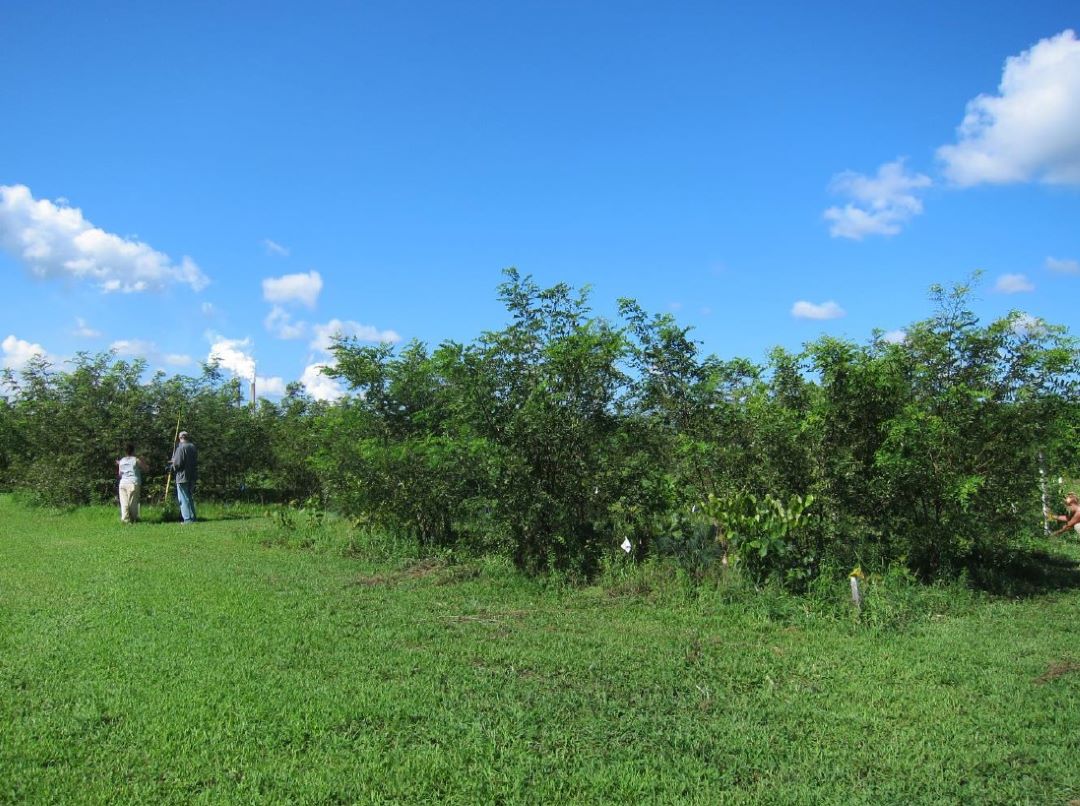Stand Initiation Diversity Experiment - SIDE (US)
The SIDE was established at the Clements State Tree Nursery in West Columbia, West Virginia in May 2012 for three primary reasons: 1) West Virginia has one of the highest levels of tree biodiversity in the country and the Nursery has a wide selection of tree species available in sufficiently large quantities; 2) the experimental sites at the Nursery are flat, productive, homogeneous, and well maintained; and 3) the proximity to professional foresters from the Nursery and the seedling source greatly reduces costs in labor, maintenance, and transportation.
 |
| An aerial view of the SIDE experimental sites in West Virginia, on the east bank of the Ohio river. A, B, and C represent a monoculture, a low diversity, and a high diversity plot |
Design
The soil and physiographic conditions are homogenous across the site. Hence, a simple completely randomized design (CRD) was used to test if both species richness and species evenness simultaneously influence ecosystem functioning, and if the spatial diversity affects the total productivity of a community. Four levels of species richness (3, 5, 7, 9) and two levels of evenness (even = 1:1, dominant = 3:1) were combined into eight treatments. Each treatment is replicated 21 times. There are 14 single-species control plots.
The plots are arranged in a 14 x 13 matrix, with 3 m spacing between any two neighbouring plots. On each plot, 77 seedlings were planted in a 7 x 11 arrangement. Plots and seedlings were randomized. The four levels of species richness consist of tree species randomly selected from a pool of 14 species that are representative of key genera to Central Appalachian forest. Each seedling was georeferenced.
 |
| species composition (July 2012) |
Site characteristics
| location | Lakins, West Virginia |
|---|---|
| former land use | reserved as overflow seedbed; unoccupied and unvegetated for the past decade |
| altitude | 184 m |
| soil type | deep and well drained loamy soils from acid materials |
| area | 3.6 ha |
| no of plots | 182 |
| plot size | 6 m x 10 m |
| no of trees planted | 15 000 |
| planting date | May 2012 |
| diversity variables | species richness evenness |
| diversity gradient | 0, 3, 5, 7, 9 sp. 2 evenness levels |
| size species pool | 14+ |
| species pool | planted species:Acer saccharinum, Alnus glutinosa,
Carya ovata, Castanea mollissima, Cercis canadensis, Cornus sericea,
Nyssa sylvatica,
Pinus strobus, Pinus virginiana (replaced by Picea abies after 1 year), Prunus serotina,
Quercus alba, Q. prinus, Q. rubra, Robinia pseudoacacia
spontaneous establishment: Acer nigrum, A. rubrum, A. saccharum, Cornus florida, C. racemosa, Populus deltoides, Quercus robur, Ulmus americana |
| contact person | Jingjing Liang |
Research
We will study the effects of tree, arthropod, and soil microbial diversity on forest productivity and resilience during the stand initiation phase in an environment or substrate devoid of vegetation, with the following three objectives:
- test and map the effects of species richness and evenness, as two distinct aspects of tree species diversity, on forest productivity
- study if tree neighborhood structure and diversity of arthropod, and soil microbial organisms have significant influences on forest productivity and resilience
- investigate the causal magnitude and direction of the biodiversity-productivity relationship in trees
Extra information
Send an e-mail to the contact person, visit the web page of the experiment, or explore the publications:
- Messier C, Bauhus J, Sousa-Silva R, Auge H, Baeten L, Barsoum N, Bruelheide H, Caldwell B, Cavender-Bares J, Dhiedt E, Eisenhauer N, Ganade G, Gravel D, Guillemot J, Hall JS, Hector A, Hérault B, Jactel H, Koricheva J, Kreft H, Mereu S, Muys B, Nock CA, Paquette A, Parker JD, Perring MP, Ponette Q, Potvin C, Reich PB, Scherer-Lorenzen M, Schnabel F, Verheyen K, Weih M, Wollni M, Zemp DC (2021) For the sake of resilience and multifunctionality, let's diversify planted forests! Conservation Letters e12829 - https://doi.org/10.1111/conl.12829
Check out the periodic photos from fixed points at the site or the SIDE movies showing the growth patterns of the SIDE trees.
 |
| August 2013 |
